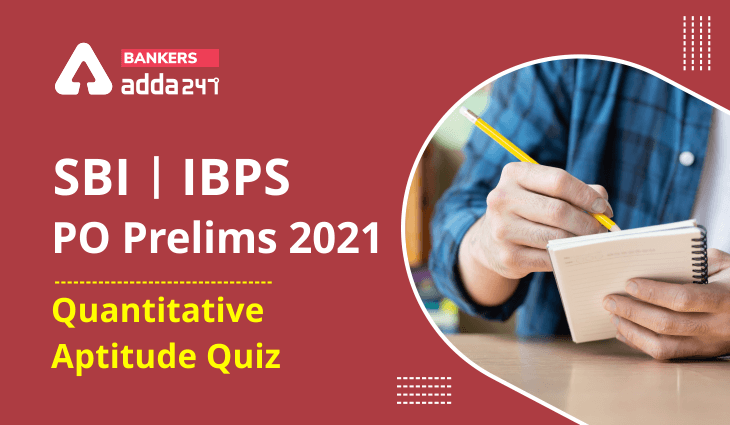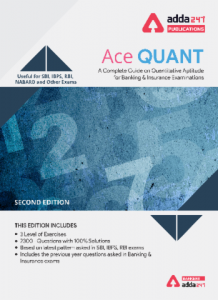Directions (1-4): The following questions are accompanied by two statements I and II. You have to determine which statements(s) is/are sufficient/necessary to answer the question.
(a) Statement I alone is sufficient to answer the question but statement II alone is not sufficient to answer the questions.
(b) Statement II alone is sufficient to answer the question but statement I alone is not sufficient to answer the question.
(c) Both the statements taken together are necessary to answer the question, but neither of the statements alone is sufficient to answer the question.
(d) Either statement I or statement II by itself is sufficient to answer the question.
(e) Statements I and II taken together are not sufficient to answer the question.
Q1. In how many days A alone will do that work?
(I) Ratio of efficiency of A to that of B is 4:5 and A alone takes 8⅓ days more than time taken by both of them together to complete the whole work.
(II) Time taken by B alone to complete 50% of the work is 9 days less than the time taken by A alone to complete the whole work.
Q2. There are total x number of balls in the bag which are of three different colors, either Red, Grey or Green. Calculate total number of balls in the bag.
(I) Probability of getting a green ball is 50% more than the probability of getting a red ball and the number of grey and green balls in the bag is equal.
(II) If two green balls are lost, then number of green balls becomes 25% of the original number of balls in the bag.
Q3. Find investment of Sandeep is what percent of the investment of Abhi?
(I) Sandeep invested for some period while period of investment of Abhi is 25% more than that of Sandeep and at the end of the year ratio of their profit share is 2: 3 (Abhi: Sandeep).
(II) Ratio of period of investment (Abhi: Sandeep) is 5: 4 and difference between their profit is Rs 1200.
Q4. Find the speed of boat in downstream?
(I) Speed of boat in still water is 50% more than speed of boat in upstream.
(II) Difference between time taken by boat to cover 32 km in upstream to that of in downstream is 2 hours.
Q5. What is the time period for which Mr. Jindal invested his capital?
I. Mr. Jindal and his partner Mr. Ravi invest in a partnership with total capital of Rs.20 lacs.
II. Ratio of time period of investment of Mr. Jindal and his partner Mr. Ravi is 4 : 5 and profit sharing ratio of Mr. Jindal and his partner Mr. Ravi is 12 : 25.
(a) Only statement I is sufficient
(b) Only statement II is sufficient
(c) Statement I and II both together sufficient
(d) Either statement I or Statement II alone sufficient
(e) Neither statement I nor statement II sufficient
Directions (6-10): The following questions are accompanied by two Quantities I and II. You have to determine relationship between both the quantities and choose an answer from given five options below:
(a) Quantity I > Quantity II
(b) Quantity I < Quantity II
(c) Quantity I ≥ Quantity II
(d) Quantity I ≤ Quantity II
(e) Quantity I = Quantity II or No relation
Q6. A solid body is to be packed in a cuboidal box.
Quantity I – Minimum volume of cuboidal box used for packaging, if solid body is sphere of radius 5 cm.
Quantity II – Minimum volume of cuboidal box used for packaging, if solid body is hemisphere of diameter 13 cm.
Q7. Quantity I– x: 6x² + 5x + 1 = 0
Quantity II– y: 20y² + 9y + 1 = 0
Q8. Quantity I – Twenty-four men can complete a work in sixteen days while Thirty-two women can complete the same work in twenty-four days. Sixteen men and sixteen women started working and worked for twelve days. Extra no. of men is to be added to complete the remaining work in 2 days.
Quantity II – Number of ways in which letters of word ‘ETEQUETTE’ be arranged so that consonants occupy only odd positions.
Q9. Quantity I– x: 2x² – 7x + 6 = 0
Quantity II– y: 2y² – y– 1= 0
Q10. Quantity I–Raj invested Rs. 15000 in scheme ‘A’ at rate of 18% p.a. simple interest for 3 years and Riya invested Rs. 18000 in scheme ‘B’ which offers 15% p.a. compound interest in 2 years. The difference between the interest earned in two schemes.
Quantity II–In 2017, A village consist of males and females in the ratio of 5: 4. If the
difference between number of males and number of females in the year 2017 is 990 and population increases by 10% every year. Number of males in 2018 if the ratio between males and females remains same every year?
Directions (11-15): Find the wrong number in the following number series:
Q11. 31, 53, 105, 182, 280, 391
(a) 391
(b) 31
(c) 280
(d) 53
(e) 105
Q12. 1, 1, 3, 23, 367, 11745
(a) 11745
(b) None of these
(c) 3
(d) 23
(e) 367
Q13. 125, 127, 137, 163, 213, 296
(a) 125
(b) 127
(c) 163
(d) 296
(e) 213
Q14. 675, 338, 170, 86, 44, 23
(a) 23
(b) 338
(c) 170
(d) 44
(e) 675
Q15. 48, 62, 96, 224, 992, 7136
(a) 48
(b) 62
(c) 224
(d) 992
(e) 7136
Solutions









Click Here to Register for Bank Exams 2021 Preparation Material





 GA Capsule for SBI Clerk Mains 2025, Dow...
GA Capsule for SBI Clerk Mains 2025, Dow...
 The Hindu Review October 2022: Download ...
The Hindu Review October 2022: Download ...
 IBPS PO Apply Online 2025, Online Applic...
IBPS PO Apply Online 2025, Online Applic...


